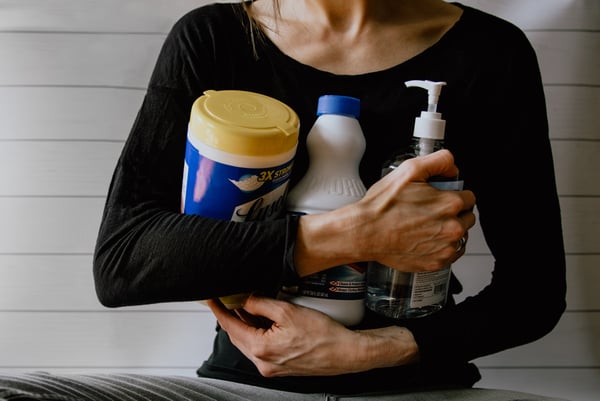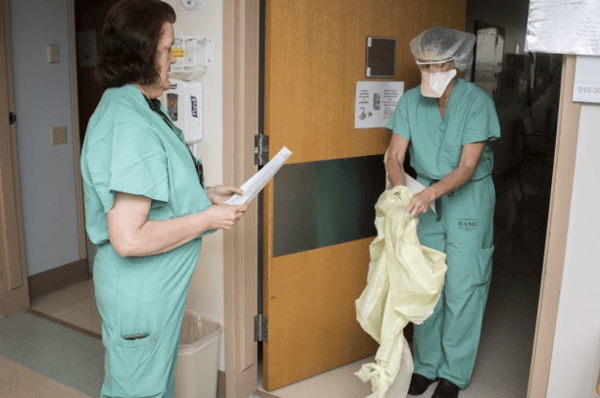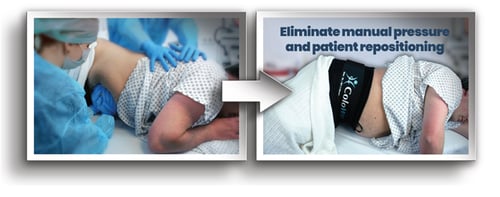How Long To Wait For Colonoscopy After Covid
COVID-nineteen and Colonoscopy: Considerations for Endoscopy Staff
by ColoWrap, on April 29, 2020
Colonoscopy is a high-touch procedure that has always placed staff at some risk for infections, merely how have things changed since the onset of the COVID pandemic? Currently, in well-nigh areas of the land, non-essential procedures like colonoscopy are on hold. However, when social distancing restrictions are lifted and the hiatus is over, a backlog of patients will require endoscopic procedures. How tin can staff, physicians, and patients all stay safe? If you don't know past at present, COVID-nineteen is a respiratory illness that spreads readily among individuals. Information technology is caused past the coronavirus, which circulates through droplets in the air and can remain feasible on surfaces for hours to days. The virus tin exist transmitted through cough or sneezing; it then enters the torso through the mouth, optics, or olfactory organ. People infected may exhibit no symptoms at all or may feel severe medical complications, for instance, pneumonia. Older adults or people with existing chronic medical atmospheric condition are at greater risk of becoming seriously ill. Anestimated 5.7% of people infected with the virus in the US take died. Because it is easily spread from person to person, WHO and the CDC warn confronting close contact (within about six feet) with anyone who is ill or has symptoms. The problem is, information technology is not like shooting fish in a barrel to tell who is infected. In fact, a recent study in the British Journal of Medicine ended that 78% of people with COVID-19 exhibit no symptoms. According to the ASGE , during upper endoscopy procedures, physicians and staff are exposed to splashes, mucus, and saliva. Specifically, patients often cough as the scope is inserted and removed and during procedures. Given the close contact amidst patients, doctors, and staff and the fact that the virus is transmitted through aerosolized droplets, upper endoscopy procedures conducted without or with minimal personal protective equipment (PPE) are a perfect environment for spreading the virus. Performing or assisting with colonoscopy was initially considered lower run a risk for coronavirus manual, but recent testify has emerged that disproves this theory. One written report establish that the virus can be transmitted through fecal matter and that viral RNA can persist in feces for up to 47 days later respiratory samples exam negative. Furthermore, when air or carbon dioxide is insufflated to improve visualization of the colon, the patient expels excess gas via the mouth or anus. Considering that the average speed of flatulence leaving the trunk is 10 feet per second , staff assisting with colonoscopy are routinely exposed aerosolized biological samples. Prophylactic recommendations for endoscopy staff include wearing full PPE, including an N95 mask; practicing strict physical distancing; and minimizing the number of people in the process room. While these safeguards brand good sense, they are not ever feasible, especially in the context of colonoscopy. First of all, there is a dearth of PPE in the U.S. The CDC stated that, "PPE shortages are currently posing a tremendous challenge to the The states healthcare arrangement considering of the COVID-19 pandemic." Second, colonoscopies involve person-to-person contact. Nurses and technicians routinely apply manual pressure level on patients' abdomens and/or reposition patients during the procedure. Not just are staff who assist with colonoscopy at run a risk for musculoskeletal disorders, they are more likely to contract COVID. Routine tasks similar applying intestinal pressure put 1 or more staff well within six anxiety of patients' aerosolized materials for a prolonged time. In addition, the physical demands of these duties increase the respiration of staff performing them. This is could potentially increment the caste of exposure. At present, more than ever, it is essential to minimize patient contact during colonoscopy to protect staff. ColoWrap is the merely clinically proven solution designed to eliminate the need for staff applied transmission pressure and patient repositioning during colonoscopy. ColoWrap delivers sustained, adjustable pressure to splint the patient'southward sigmoid and transverse colon, resulting in a 90% reduction in the need for staff applied manual pressure and patient repositioning, quicker and easier scope advocacy, and improve procedure outcome. And because staff are not applying transmission pressure repositioning patient, they are able to maintain a safe physical distance during the exam. A COVID Primer

COVID and Upper Endoscopy
Colonoscopy in the COVID Era
How to Stay Safe During Colonoscopy

ColoWrap Protects Confronting Injury…and (Potentially) Coronavirus
 Well before COVID, endoscopy professionals were aware of the importance of infection control . In the current surroundings, boosted measures must exist taken to protect staff. If possible, PPE should exist worn during every endoscopic procedure, and social distancing should be adept. In improver, using ColoWrap can help to limit patient contact during colonoscopy; it's an easy way to keep staff safe during colonoscopy. Click below to acquire more about how to implement ColoWrap in your unit as you restart procedures.
Well before COVID, endoscopy professionals were aware of the importance of infection control . In the current surroundings, boosted measures must exist taken to protect staff. If possible, PPE should exist worn during every endoscopic procedure, and social distancing should be adept. In improver, using ColoWrap can help to limit patient contact during colonoscopy; it's an easy way to keep staff safe during colonoscopy. Click below to acquire more about how to implement ColoWrap in your unit as you restart procedures.
Source: https://www.colowrap.com/blog/covid_colonoscopy

0 Response to "How Long To Wait For Colonoscopy After Covid"
Post a Comment